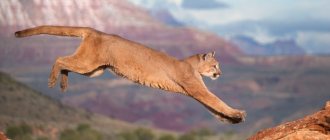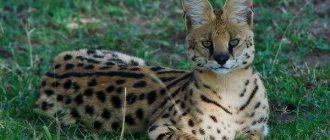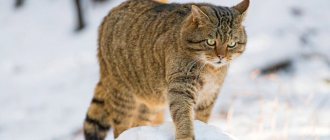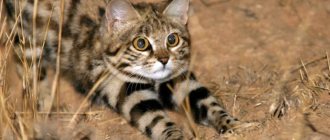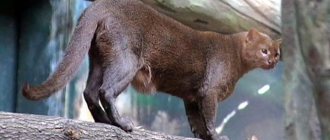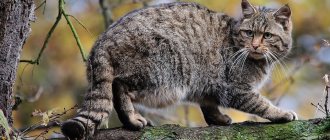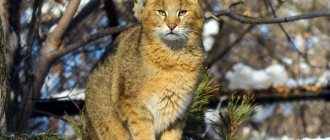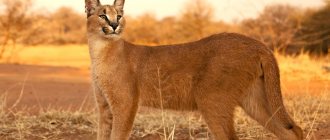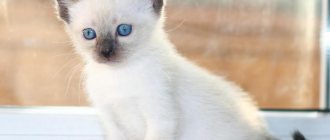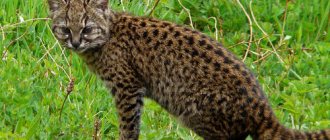The lion is one of the large predatory animals belonging to the cat family. There are several varieties of this animal; in addition, many hybrids are known that appeared from the mixing of different species. Each of them has certain characteristics, but also has similarities. The local population of the lands that are located near the habitat of the beast calls it a “wild cat” and considers it dangerous, and tries to destroy it. Because of this, the population of these animals has greatly decreased. Meanwhile, the lion is an interesting and unique animal, so it’s worth knowing how it differs from other representatives of the fauna.
Leo - characteristics and description
When characterizing an animal such as a lion, you need to provide a description of it. The different species are slightly different from each other, but they have a lot in common.
The animal belongs to the cat family, therefore in appearance it is similar to domestic cats, only it is significantly larger than them. It is one of the largest representatives of this family, second only to the tiger.
The body of the animal is flexible and mobile; they have well-developed muscles of the front legs and neck. There are claws on the paws, the length of which reaches 7 cm. Its head is large, with an elongated muzzle and strong jaws. His fangs are long (about 8 cm), the number of teeth is 30. These features give the lion the ability to hunt large herbivores. The tongue is covered with tubercles, thanks to which the lion can clean its fur from dirt and eliminate insects.
On the muzzle there are whiskers, at the base of which there are small dark spots. These spots form a pattern unique to each animal. Cubs are born spotted, but as they grow older, the spots on their body disappear, and the color of the coat becomes uniform - brown or sand. At the tip of the animal's tail there is a black tassel.
The main feature of this animal species is sexual dimorphism. A male lion and a lioness have significant differences. For example, it is impossible to say how much a lion weighs on average without knowing the sex of a particular individual. Males are significantly larger than females in size and weight. In addition, their head is decorated with a mane, which begins to grow in lion cubs from the age of 6 months. The length of the pile and the thickness of the mane depend on age and genetics.
Body type
If you look at a photograph of a lion, you will notice that it is very similar to a big cat. This animal is the largest representative of the cat family. In size it can only be inferior to tigers.
He has a flexible and agile physique, with well-developed muscles in the neck and front pair of paws, on which claws are located, reaching a length of seven centimeters. A large head, an elongated muzzle and a powerful jaw distinguish this animal from the rest.
How much does a lion weigh?
How much an adult lion weighs on average depends on the characteristics of its life. But gender especially affects this indicator. The differences in the main parameters are shown in the table.
| Males | Females | |
| Body length | From 1.7 to 2.5 m | From 1.4 to 1.45 m |
| Weight | From 150 to 250 kg | From 120 to 180 kg |
| Shoulder height | Approximately 1.2 m | Approximately 1.07 m |
| Tail length | From 0.9 to 1.05 m | From 0.7 to 1 m |
Despite its massiveness, this predator has the smallest heart size. Therefore, a lion cannot be called hardy. It can reach speeds of up to 80 km/h, but only covers short distances.
Scorpio is a dangerous Abyssinian hooligan
Scorpios are people who balance on extremes. They immediately stand out from the crowd with their special magnetism and gaze. And although on the outside it may seem that this person is reserved and observant, inside such a comrade volcanoes are boiling. Scorpios are sensitive, often calculate all steps in advance and love to create a mysterious, and even somewhat frightening, atmosphere around themselves. Perhaps this is why they gravitate towards black cats and firmly believe that they bring them good luck. What’s nice is that cats also feel great in their company. It is also worth taking a closer look at the Abyssinian and Bombay breeds.
Features of life and habitat
When describing any animal, you need to consider not only its appearance. It is also worth finding out how long a lion lives and where it lives.
There are few places where such an animal as a lion lives. In recent years, its distribution area has decreased significantly. Previously, this animal was found not only in Africa and India, as it is now, but also in Iran, Russia, southern Europe and the Middle East. But a significant part of the population was exterminated, and conditions in many areas became unsuitable for their life. Therefore, of all the places where these animals could previously be seen, the lion now lives only in the southern part of the African continent (beyond the Sahara Desert) and in the Indian state of Gujarat. The most suitable for them are savannas, forests or bushes.
Individuals unite in small flocks - prides. A pride consists of 5 or 6 related females, their cubs and a male. In some prides there may be two males if they are brothers. Young males, having reached maturity, leave the pride (they are expelled). They have the opportunity to join another pride or create their own. Some of them lead a solitary life.
Gemini - fidgety American Curl
But for Gemini the situation is completely opposite. Geminis will always find somewhere to run and what to watch, even if there was no business as such. Restless and interested, they invariably find something to satisfy their curiosity. What’s nice is that their mood is almost always positive and on the rise. The nimble American Curl is always ready to share new impressions with them.
What does a lion eat?
How much a lioness or male lion weighs depends on their feeding habits. Since the lion is a predator, it leads a hunting lifestyle, feeding on fairly large animals. They may be:
- deer,
- wild boars,
- antelope,
- zebras,
- buffalos,
- giraffes,
- livestock.
In rare cases, the animal may attack a hippopotamus or small elephant. Sick cheetahs, hyenas and leopards can also become its prey.
Lionesses excel in hunting. They are distinguished by dexterity and agility. Hunting is more difficult for males due to their large size and heavy mane. However, the male needs more food. An adult lion eats about 7 kg of meat per day, while a female needs 5 kg. These animals prefer to hunt at night, creeping up to the prey as far as possible.
Biology and Behavior
Leos rest about 20 hours a day. They are most active after sunset, although they can go hunting at any time of the day. Lionesses most often hunt in the evening or before dawn. On average, they spend about an hour a day eating and two hours walking.
Social organization
Lions have two types of social organization. Most of them live in prides. Typically, a pride consists of several related females, their cubs of both sexes, and one or more males (if there are several males, the pride is called a coalition - usually exists between male lions - blood brothers), who mate with adult females. The number of males in a coalition is usually two, but the number can increase to four. Young males, upon reaching sexual maturity, leave the pride.
The second type of social organization is the wandering lion. They roam singly or in pairs within their range. Wandering lions are often males who have been expelled from the pride into which they were born. Most young males go through this, and some remain single for the rest of their lives. There are times when lions change their lifestyle. Sometimes wandering lions form their own pride, or join an existing one, and those living in the pride leave it. Since most often lionesses in a pride have family ties and, as a rule, expel strangers, it is much more difficult for a female who is left alone to join another pride.
The area occupied by a group of lions is called “pride territory.” Typically, males patrol the boundaries of the territory, guarding and protecting the pride from rivals. Hunting is carried out mainly by lionesses, who are smaller in size and faster and more flexible than males. Lions have a harder time hunting. The reason for this is the mane - it leads to overheating during physical activity. Females act in a coordinated manner during the hunt, which allows them to attack prey more successfully. However, males dominate when dividing the prey. Moreover, males are more willing to share prey with lion cubs than with females. If the male gets the prey himself, then, as a rule, he eats it himself. Small prey is eaten by lionesses on the spot, and large ones are dragged to the pride territory. There, all family members have access to it. Often on the spot, lions behave aggressively towards each other, trying to grab as much food as possible.
The social organization of lionesses is considered the most perfect among cats. Its reasons are the subject of much debate. The most obvious may seem to be an increase in hunting productivity. But at the same time, the amount of food for each individual of the pride, taking into account those who did not take part in the hunt, decreases. On the other hand, such an organization allows individual lionesses to concentrate on courting and protecting their offspring, without taking part in food production.
Each member of the pride performs a specific, more or less constant role during the hunt. A key factor in the survival of a pride is the health of those participating in the hunt. Therefore, they are the first to get the right to their part of the carcass.
Females, like males, protect the pride territory from outsiders. However, in a pride these responsibilities are distributed unevenly: some individuals constantly drive away strangers, others stay aloof. Those who remain on the sidelines serve another key role. Lions protect the pride from invasion by other males; lionesses show the same activity towards other females. Typically, the number of females changes only after the birth of cubs or the death of one of the lionesses, although some of them may leave the pride and become nomadic. Males always leave the pride at the age of 2-3 years.
Hunting and food
Leo is a strong animal. Lions hunt in packs, in coordinated groups, and stalk one chosen prey. Lions have little endurance - they show high speed only at a short distance and try to get as close as possible to their prey before attacking. They also skillfully use natural environmental factors: for example, they hunt at night, when their potential prey cannot distinguish them well.
Lions quietly creep up to a herd of ungulates, gradually closing the distance. Typically the distance to the herd is 30 meters or less. Often several lionesses surround the herd from different sides, and as soon as the herd is surrounded, they pounce on the nearest animal. A powerful attack occurs, during which the predator tries to catch its prey in a quick jump. Prey usually dies from suffocation or fracture of the cervical vertebrae. Small animals can be killed by a paw.
The main prey of the lion are large ungulates, preferably with a body weight of 50 to 500 kg. In Africa, the lion hunts zebras, wildebeest, warthogs and buffalo. Indian lions consider nilgai, wild boars and several species of deer as their prey. Other animals become potential prey as they become available. Sometimes lions are content with springboks and Thompson's gazelles. Although, when hunting in a pack, lions are capable of killing even a very large animal, in most cases they do not attack adult giraffes, elephants and rhinoceroses, since as a result of the attack there is a high probability of injury, or even death, to one of the attackers.
The main prey of lions in Africa are wildebeest and zebras. Animals that are too fast or strong are usually excluded from the diet. But despite this, giraffes and buffaloes are often the main food of lions, for example, in the Kruger National Park in South Africa. In Manyara Park in South Africa, due to their large numbers, 62% of the lions' diet comes from Cape buffalo. Sometimes hippos become victims of lions. And in some areas, lions prey on animals that are completely atypical of their diet. In Chobe National Park in Bostwana, lions actively attack elephants. The park management reported that at first the big cats attacked elephant calves, then young animals, and then at night, taking advantage of the poor vision of the thick-skinned giants, they began to attack adult animals. Lions can attack livestock - in India this makes up the majority of their diet. They can also kill other predators - leopards, cheetahs, hyena dogs - and also use animals that have died from disease or fallen prey to other predators as food.
In one sitting, a lion can eat up to 30 kg of meat. If the prey was not eaten at one time, he waits several hours before approaching again. An adult salmon requires 7-8 kg of meat per day. As an adult female, about 5 kg is enough.
Since the main prey of lions tries to stay in open space in order to easily notice the predator, only coordinated actions of the pack lead to a successful hunt. This is especially true for hunting large animals. Males usually do not take part in the hunt, and help only when the prey is a large animal - for example, a buffalo or giraffe.
The young animals watch the hunting of adult animals and begin to join the action only after reaching one year. Lions become full-fledged hunters after reaching two years of age.
Reproduction and life cycle
Most lionesses are capable of breeding from the age of four.
Males begin mating from the moment the female comes into estrus. A lioness can mate with several males at the same time if she ovulates. During the mating period, which can last several days, lionesses mate 20-40 times a day, and, as a rule, refuse to eat. In captivity, lions reproduce quite well.
A lioness's pregnancy lasts an average of 110 days, after which up to 4 cubs are born. Pods usually take place in a secluded area, away from the rest of the pride. The female begins to hunt herself not far from the place where the cubs are hiding. Lion cubs are born blind and helpless. Their eyes open around the seventh day after birth. Babies begin to crawl within a day or two and walk in the fourth week of life. The weight of a newborn lion cub is 1.2-2.5 kg. The female regularly moves the cubs to a new place to avoid the accumulation of odor in the den, which can attract predators.
Usually the female returns to the pride when the cubs reach 6-8 weeks. If the birth occurred at the same time as other lionesses, she may return earlier.
Young lion cubs are sometimes at risk of starvation. Other animals also pose a threat to children - leopards, hyenas, jackals, eagles, snakes; even buffalos, hearing the smell of lion cubs, attack the den and try to trample the cubs while the lioness is hunting. About 80% of all lions die before the age of two.
When meeting other members of the pride, the lion cubs experience fear. But then they begin to actively play with each other and adult members of the pride. Females are more tolerant of their own cubs than of the cubs of other lionesses. Males treat babies differently: sometimes they drive them away, and sometimes they join in the game.
Milk feeding occurs until 6-7 months. During this time, the cubs must learn to eat prey with everyone else.
Males reach sexual maturity at 3 years, and by 4-5 years they are able to displace other males from the pride. Upon reaching 10-12 years of age, lions lose strength and become weaker. Quite often, they do not live to this age at all, dying while defending the pride, becoming a victim of a person, or for other reasons. Males are rarely lucky enough to capture any pride again. When a pride is captured, lionesses fiercely protect their cubs from other lions.
But it’s not only males who can be expelled from a pride. A generation of young females may be forced to leave the pride and go off to find their own territory when the pride becomes too large. In addition, with a new male lion, all immature individuals are often kicked out of the pride. Life for female nomads is very harsh. It is not often that they manage to raise cubs in the absence of pride support.
Natural enemies, diseases and parasites
An adult lion has virtually no natural enemies due to its size and strength. Lions can become victims of other lions, dying in fights. The percentage of deaths of lions from such cases is quite high. When members of different prides clash or when males of the same pride fight, lions quite often inflict serious injuries on each other. Lion cubs, as well as individuals who suffer from illness, injury, or have lost strength due to hunger during a drought, can become victims of leopards, hyenas, or be killed by buffaloes or elephants. There are also cases when lions died while hunting.
Despite the fact that the lion is the king of beasts, it suffers quite a lot from parasites. The body parts of lions with thin skin are affected by different types of ticks. And if the lion cannot reach there with his teeth or paw, then the insects cause the animal great trouble. Among lions, infection with helminths is common, in particular tapeworms from the genus Taenia, which enter the intestines. Infection usually occurs through the meat of eaten antelopes.
While in captivity, lions can be susceptible to canine distemper virus (infected from dogs), feline infectious peritonitis and feline immunodeficiency virus. An outbreak of the disease in 1994 in the Serengeti Game Reserve resulted in several individuals becoming ill with neurological symptoms such as seizures. During this outbreak, several lions fell victim to encephalitis and pneumonia. The feline immunodeficiency virus, which is similar to HIV, mainly affects lions from Namibia and Asia.
Communication
While resting, lions communicate through movements. Such gestures include rubbing the head and licking the “interlocutor,” which has been compared to grooming in primates. As a sign of greeting, lions rub against the head, neck or muzzle of another lion. Lions use this sign if the animal returns to its relatives. Males usually rub against other males, and cubs rub against their mothers.
There are many postures and facial expressions that are used as visual gestures. They also make sounds that vary in strength and pitch. Lions growl, purr, hiss, cough, bark and roar. The roar occurs in a characteristic manner, starting with a few deep sounds and ending with strong ones. Lions often roar at night, and the sound of their roar can be heard up to 8 km away. This is how they signal to other animals.
Relationships with other predators
In places where the habitats of lions and spotted hyenas coincide, there is direct competition between them. Often the diet of these two species is the same. Lions usually ignore hyenas if they are not aggressive. Sometimes hyenas eat food with lions. But both lions and hyenas can be aggressive towards each other even in the absence of prey. Lions may attack hyenas for no apparent reason. In captivity, hyenas who have never seen lions may be indifferent to them, and yet react with fear to their latter.
Where the habitats of lions and other big cats - cheetahs and leopards - coincide, clashes also occur. 90% of cheetah cub deaths occur due to lion attacks. They also quite often take away cheetahs' prey. Therefore, cheetahs try not to compete with lions in the hunt and hide their cubs under low bushes. In turn, leopards hide their prey and kittens in trees, although this tactic does not always work, since lionesses often successfully climb trees. Lions often hunt hyena-like dogs, attacking even adult individuals.
The only predator that poses a threat to the lion is the crocodile. If a fight occurs, these two species can cause significant damage to each other. Lions attack crocodiles when they come onto land, and crocodiles attack lions when they enter the water.
Lion breeding
Reproduction in lions is not tied to the time of year, but begins with reaching maturity. Males are considered sexually mature at the age of 6 years and females at the age of 4 years.
Males tend to fight for females. Sometimes these fights are so brutal that the competitor dies.
The duration of pregnancy in these animals is 110 days. Shortly before giving birth, the lioness leaves the pride and hides. She can give birth to 1-4 cubs, whose weight is slightly less than 2 kg. Lion cubs are born blind, and they open their eyes only 7 days after birth. For safety reasons, the mother changes her place of stay several times, carrying her children with her. She hunts and feeds her babies with milk. Training cubs to hunt begins at the age of 1.5 months, at which time the entire family joins the pride. With the beginning of the hunt, lion cubs gradually eat meat, although the period of milk feeding lasts about six months.
Libra - Bengali aristocrat
It’s just the way the stars are aligned, but Libra always attaches great importance to the visual component and harmony of form. These people are very scrupulous about themselves and their appearance and always think about the impression they cause. Bengal cats are not just cats, but works of art that not only delight the soul, but also caress the eye. Libra is ready to put up with innocent pranks and other hooliganism of their favorite, but never with the fact that guests will not pay attention to her and sincerely admire her. They should choose a Bengal cat, which combines a chic appearance and a playful, affectionate character.
Lifespan of a lion
One of the important aspects of describing these animals is the question of how long a lion lives. To answer it, you need to take into account many circumstances. How long a lion lives depends on features such as:
- Habitat. The better the living conditions, the longer its duration.
- Closeness to people. In close proximity to humans, the risk of extermination of these animals and shortening their lifespan increases.
- Features of life. Lonely individuals live shorter lives than those belonging to a pride.
- Floor. Females have a longer lifespan on average than males because they are less likely to die during fights with other lions.
All these nuances affect how long a lion lives. Therefore, their lifespan varies greatly. On average it is 8-10 years. Some individuals live up to 14 years.
How long a lion lives is greatly influenced by the behavior of people. It has much more impact than other factors. If people do not seek to destroy these animals, then their life expectancy increases. Better results can be achieved if you organize living conditions suitable for animals, for example, nature reserves or zoos. In this case, lions can live 20 or even 25 years, since they are monitored by veterinarians.
Aries - restless Burmese shorthair
Aries never sit still, and sometimes it seems like they have an Energizer battery inserted into them. And when the owner is energetic and active, then it is worth finding a pet to match, otherwise the animal may simply get tired of the constant excitement. The Burmese Shorthair will perfectly cope with the impulsive nature of Aries and will keep him company in his restless movement.
Types of lions
How long a lion lives depends also on the variety of this animal. There are several subspecies of lion, each of which differs in certain characteristics, habitat, living conditions and its duration. Some subspecies of this animal have already become extinct, others are at the stage of extinction. There are also several hybrid varieties resulting from crossing with tigers, leopards or jaguars.
Asiatic lion
Scientists identify 8 main subspecies, one of which is the Asiatic lion. Another name for the subspecies is the Persian lion (or Indian). The Asiatic lion lives in the southern part of Eurasia. Its main habitat is the Girsky Nature Reserve in the Indian state of Gujarat. The Asiatic lion is considered an endangered species. This subspecies is characterized by stockiness. Males are slightly more than a meter in height. Due to its sleek and sparse mane, the Asiatic lion does not seem as large as representatives of the African subspecies. The body weight of males is from 160 to 190 kg, lionesses usually weigh 90-120 kg. The length of the body is 2 - 2.5 m. The largest Asian lion has a length of 2.92 m.
African lion
The remaining species are found in Africa, which is why they can all be classified as the African lion subspecies. They are characterized by certain general features, for example, sexual dimorphism, coat color, characteristics of life and reproduction, and so on. Differences may be in body size and weight.
- Barbary. This subspecies is the largest. It used to spread throughout the African continent, but is now completely exterminated. Males had a mass of up to 270 kg, females - up to 170. Currently, the descendants of these animals can be seen in zoos and nature reserves, but they cannot be called purebred.
- Senegalese. This is also an African lion, living in the west of the continent. The size of these animals is small, the color of the coat is light. Males have almost no mane, or it is very short. You can meet representatives of this subspecies in Nigeria, Guinea and Senegal. Senegalese lions are considered endangered.
- Northern Congolese. It has all the external features that distinguish the African lion. Its habitat is savannas in the northeast of Congo. The population size of these animals is gradually decreasing.
- Maasai. Otherwise it is called East African. It differs from other varieties in having longer legs. Their mane is directed back. The male's body length is 2.5-3 m, the female's is 2.3-2.6 m. These animals inhabit Uganda, Zambia and Mozambique. A large number of Masai lions are kept in the Masai Mara Game Reserve in Kenya.
- Katangese. This species is on the verge of extinction. The bulk of it lives in southwest Africa (Zimbabwe, Angola). In length, adult males reach 3.1 m, females - 2.65 m.
- Transvaal. These are lions with black manes. Among the representatives of this subspecies there are individuals whose skin and fur do not have melanocytes. Because of this, they have white fur and pink skin. A lion can be from 2.6 to 3.2 m in length, a lioness - 2.35-2.65 m. Transvaal lions live in southern Africa (Kalahari Desert). They are also kept in the Kruger National Park.
- Cape. This species of animal was destroyed in the 19th century. They lived at the Cape of Good Hope (southern Africa). The peculiarity of the species was the black tips of the ears and the presence of a mane on the stomach and shoulders.
This classification is not the only one. There are others to which scientists can add other subspecies.
Leo - Maine Coon Royalty
The self-importance of Leos is legendary. And you can make fun of this moment as much as you like, but the fact remains: Leo always chooses only the best for himself and his family. He values regalia, origin and pedigree very much. Such comrades, as a rule, love cats very much, and choose a pet that matches their nature. In this case, you can choose the king of cat breeds - the Maine Coon. The cat (but almost a tiger in appearance) leaves no one indifferent due to its impressive appearance and grace. Interestingly, ginger cats are very suitable for Leos - they literally add brightness and mood to their home.
Interesting varieties
A notable species of these animals is the mountain lion. It is not very similar to its other relatives; it differs in size and habitat. The mountain lion is distributed throughout America. Its body is from 1 to 1.8 m in length, and its weight can reach 105 kg. This is significantly less than other subspecies. The mountain lion also lacks a mane. Color can vary from gray-brown to brown-yellow. Cougar cubs are born with dark spots and stripes on their bodies, but after 9 months of life these markings begin to fade. The mountain lion prefers to live alone. The exception is the mating season and the time of raising cubs.
Another subspecies that may be interesting is the cave lion. It is included in some classifications, despite the fact that the cave lion is an extinct species, and it became extinct several thousand years ago. During their lifetime, these animals inhabited Siberia and Europe. The cave lion is one of the ancestors of modern lions. The cave lion was larger than its descendants. If you believe the images of these animals, they did not have a mane, or it was very small. It is not known for sure, but there is an assumption that this subspecies of animals also united in prides.
Despite its name, the cave lion never lived in caves. They were chosen by old and sick individuals shortly before death, which is why the largest number of remains of these animals were found there. That's why the cave lion was named so. The cave lion hunted deer and bears. This is how scientists explain the extinction of these animals. With the onset of warming, the number of bears and deer decreased, and the cave lion was not adapted to a different diet.
Habitat
Scientists suggest that approximately 20 thousand years ago, the white lions of Africa lived among endless expanses of snow and ice. And that is why they have a snow-white color, which served as excellent camouflage during hunting. As a result of changes in climatic conditions on the planet, white lions became inhabitants of the steppes and savannas in hot countries.
Due to its light color, the lion becomes a rather vulnerable animal, which during the hunt cannot provide enough cover to get the required amount of food.
And for poachers, the light skin of an animal is the most valuable trophy. Lion cubs with such an “unusual” color for nature find it very difficult to hide in the grass and, as a result, they can become prey for other animals.
The largest number of white lions is located in the west of South Africa in the giant Sambona Nature Reserve. For them, and other species of rare animals, conditions as close as possible to natural habitats in the wild have been created.
Humans do not interfere with the processes of natural selection, hunting and reproduction of the inhabitants of the protected area. The largest zoos in countries such as Germany, Japan, Canada, Russia, Malaysia, and the USA contain this legendary animal in their open spaces.
Black and white lions
A lion is an animal that has many interesting features. One feature concerns the coloring. Some classifications mention varieties such as white lion and black lion. But this is wrong. If a lion with a dark or black mane is a real existing subspecies, then animals with white or black coloring are considered an anomaly.
At the same time, it cannot be said that a lion with an exotic coloring is a fiction. There is a genetic mutation called leucism. Because of it, the fur of animals turns white. This occurs due to a lack of melanocytes. The result is the appearance of an animal such as a white lion. One might assume that this is an albino lion, but the color of its eyes, which can be either blue or gold, says otherwise.
The white lion is almost no different in its characteristics from other representatives of the species. It is slightly larger than the others. Their weight can reach 310 kg, and the male’s body length exceeds 3 m. The females of such animals are slightly smaller - 2.7 m. A lion with white fur changes color slightly throughout its life, and by old age its body acquires an ivory shade.
The black lion, according to many scientists, does not exist in nature. They consider photos and videos of such animals found online to be the result of shooting in the dark or special processing. Some suggest that, as opposed to albinism, there is a phenomenon of melanism, in which there is too much pigment in the fur of animals. This is possible in jaguars and leopards. As a result of crossing, a lion with a dark shade of fur may be born, but this is only an accident, so there is no need to separate such animals into a separate subspecies.
Interesting Facts
- A white lion cub can be born even to a cream-colored female. However, it will be difficult for him to survive among “his own people.”
- Because he is different from other lions, his relatives can simply destroy him. In nature, white is a poor camouflage color and an excellent bait for enemies (hyenas).
- In captivity, they can live about 20 years.
- The white lion is not a separate subspecies. His difference from others is caused by a genetic disease (leukism). The recessive gene actually causes the appearance of such an unusual color.
- Only 300 individuals of white lions live on earth at present. Every single one is listed in the Red Book. This figure is a real achievement, because several hundred years ago there were only three of them.
- They are practically never found in the wild. They are specially bred in zoos.
Video
Sagittarius - exotic, smart Ocicat
Let's start with the fact that Sagittarians are rarely at home - the world is too huge and attractive. Such people are focused on conquering new horizons, expanding their spheres of influence, and are also known as avid travelers. Perhaps one day, just from such a trip to distant countries, Sagittarius will bring back his favorite. Large and prestigious cats are held in high esteem here, and, importantly, they are smart. In general, these are pets that you can sincerely be proud of. The Ocicat breed combines activity, love of life and outstanding intellectual abilities, which means it will become Sagittarius’s best friend.
